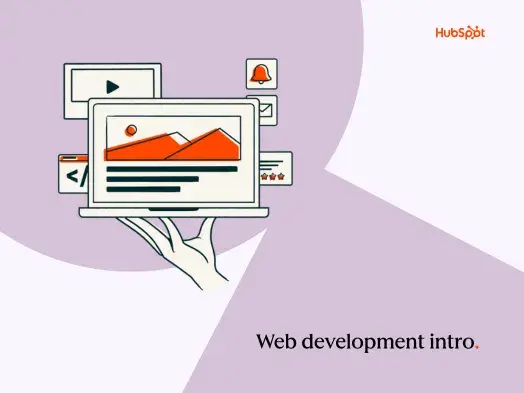We want to help. That’s why we gathered a list of essential web development interview questions. Get a sense of what you should prepare for and how you can answer.
Table of Contents
- Beginner Web Development Interview Questions
- Intermediate Web Development Interview Questions
- Advanced Web Development Interview Questions
Beginner Web Development Interview Questions
When you’re interviewing for a role, you’ll likely receive a mix of questions. Some will be geared toward beginners. Here are some basic questions you’ll be expected to know when you start the job search.

1. What is HTML, and why is it important in web development?
Answer: HTML stands for HyperText Markup Language. This coding language is used to structure web content. Here, you can specify what content appears and where — that includes placing images, text, and links. HTML forms the building blocks of web pages. The latest version of this language is HTML5.
2. What is CSS, and how does it contribute to web development?
Answer: If HTML builds the foundational elements of a site, CSS allows you to decorate. CSS, or Cascading Style Sheets, is used to make your content visually appealing. You can choose colors, fonts, spacing, and more. CSS also allows you to build columns and grid layouts across your site.
3. Explain the role of JavaScript in web development.
Answer: JavaScript adds interactivity and dynamic behavior to websites. You can use this language to create dynamic content updates and validate information from forms. JavaScript also powers a number of interactive elements you see online. That includes dropdown menus and image carousels. This client-side scripting language runs directly in the user's web browser.
4. What is an API, and what role does it play in web development?
Answer: APIs, or Application Programming Interfaces, allow software applications to interact with each other. In web development, APIs allow you to integrate different systems and services into your project. Developers can retrieve data from external sources through APIs. They can then perform actions on remote servers or databases.
APIs also let you integrate third-party services into applications. That's helpful if you need payment gateways, map services, or email providers. This empowers developers to leverage existing functionalities with ease. You can then build feature-rich web applications without starting from scratch.
5. What is AJAX, and how does it work?
Answer: AJAX stands for Asynchronous JavaScript and XML. This technique used in web development creates dynamic and interactive web applications.
The result? Web applications that have a smoother and more responsive user experience. That’s because only the necessary data or content is updated. There's no need to reload the entire page. AJAX does this by using a combination of JavaScript, XML, or JSON), HTML, and CSS.
6. What does DOM stand for, and what does it do?
Answer: DOM stands for Document Object Model. This is a programming interface that represents the structure of an HTML or XML document as a tree.
The DOM tree consists of nodes. Each node represents an HTML element or other types of content in the document. Nodes have parent-child relationships. The top-level node is called the document node, which represents the entire HTML or XML document.
The DOM provides a way for programs, such as JavaScript, to access and manipulate the content of a web page.
7. What does the term web hosting mean in web development?
Answer: Web hosting companies provide storage and servers, allowing customers to publish websites or applications on the internet. Websites consist of many files, including HTML, CSS, JavaScript, images, and databases. These files must be stored on a server so they can be accessed by visitors. Web hosting companies provide the infrastructure that makes this possible.
Hosting providers allocate server space and bandwidth for different websites. You can pick between different plans and packages offered by the company.
8. Explain the concept of “browser compatibility.”
Answer: Browser compatibility refers to a website’s ability to work correctly across different web browsers. Visitors may be using Chrome, Firefox, Internet Explorer, or Safari. You want your websites and applications to work well on all these different browsers. By guaranteeing compatibility, you can build a better experience for all of your users.
9. What is a responsive website, and why is it essential?
Answer: People may visit your website from their desktop, on the go from their phones, or on tablets of different sizes. You want your content to look great on all of these different screens. A responsive website makes all of this possible.
Responsive sites adapt their layout and design for different screen sizes. You’ll have user-friendly experiences, even when users are on the go — conveying professionalism across the board.
10. How can you view the source code of a webpage in a browser?
Answer: How you view source code varies based on your browser and the operating system that you’re using. However, you can often right-click anywhere on a webpage. From the context menu, select “Inspect,” “Inspect Element,” or a similar option.
You can also access the Developer Tools by pressing the F12 key, Ctrl+Shift+I on Windows or Cmd+Option+I on macO. This reveals the HTML and CSS code used on the webpage.
11. What is a tag in HTML, and how is it used?
Answer: In HTML, tags are markup elements used to define the structure and content of a page. HTML tags are enclosed within angle brackets (“< >”) and come in pairs — an opening tag and a closing tag. Opening tags indicate the start of an element, and closing tags signify its end. Some self-closing HTML tags do not require a closing tag.
Let’s look at the following line of code.
- <p>This is a line of <strong>code</strong> in HTML.</p>
<p> and <strong> are two HTML tags.
12. Describe the differences between responsive and adaptive web design.
Answer: To answer this question, let’s check out two definitions. Responsive web design uses fluid grids and flexible layouts to change websites for different screen sizes.
With responsive design, the layout of the webpage adjusts dynamically based on the device's screen size. This means that the same HTML and CSS code are delivered to all devices. The webpage adjusts its presentation accordingly. Media queries are used in this process.
Meanwhile, adaptive web design involves creating multiple versions of a website. Each version is specifically designed and optimized for different screen sizes. This approach detects the characteristics of the user's device and delivers the version of the website that matches. JavaScript is often used in this process.
13. What is a web browser, and how does it work?
Answer: Web browsers are software applications that let you access the internet. When you enter a website address, your browser sends a request to a web server. The server then sends the requested data back to the browser. Your browser then interprets that information. Then, what you're looking for is displayed on your screen.

14. What does WYSIWYG stand for, and how is it used in web development?
Answer: WYSIWYG stands for “What You See Is What You Get” — a phrase often used to refer to web design tools that allow you to create webpages visually. WYSIWYG editors show you how they will appear to users while you edit. This editing experience saves time. Additionally, non-developers can build on these platforms, making professional-looking content with minimal coding effort.
15. Explain the concept of “cache” in web browsers.
Answer: The browser cache is like a temporary storage space for web files — that includes images and stylesheets.
Let’s say you just fixed a problem in your source code, but it has not been resolved on your website. Clearing the cache can resolve webpage issues by ensuring that you have the most up-to-date version of a webpage. This eliminates any conflicting or outdated data stored in your browser.
16. What is a web server in the context of web development?
Answer: Web servers refer to both software and hardware components that host and deliver web content to users. Servers handle requests from web browsers and serve webpages, files, and other resources over the internet.
Web server software, such as Apache HTTP Server or Nginx, runs on a physical server or cloud platform. It listens for incoming requests on specific ports and then delivers content.
In terms of hardware, web servers can be physical machines located in data centers or virtual machines running on cloud infrastructure. The hardware resources and specifications of a web server depend on the expected traffic and workload.
17. What is a content management system (CMS), and why might you use one in web development?
Answer: A CMS is a software platform that simplifies website creation and management. It’s beneficial when you want to build and update websites without extensive coding skills. Popular CMSs include WordPress and Joomla.
18. What is the difference between inline and block-level elements in HTML?
Answer: Block-level elements create line breaks before and after themselves. These elements occupy the full width available within their parent container. They typically start on a new line and stack vertically on top of one another.
Conversely, inline elements don’t create line breaks. They occupy only the necessary width to contain their content. These elements flow alongside other inline elements within a line of text.
19. What is a callback function in JavaScript?
Answer: In JavaScript, a callback function is given to another function so that it can call it later. Callback functions handle tasks that might take some time to finish, like fetching data from a server or responding to a click.
Callbacks are useful in situations where you want your program to keep running smoothly without waiting for a time-consuming task to complete.
20. Explain the difference between session storage and local storage.
Answer: These storage options are both available in modern web browsers to store data on the user's device.
Session storage is specific to each individual browser tab or window within a particular browsing session. Each tab or window maintains its own separate session storage area. The data stored in one session storage is not accessible by other tabs or windows.
Local storage is shared among all tabs and windows within the same origin. This means that data stored here can be accessed and shared across multiple tabs or windows.
Intermediate Web Development Interview Questions

1. What are promises, and how do they differ from callbacks?
Answer: JavaScript uses both promises and callbacks to handle asynchronous operations. However, these two methods have different approaches and syntax.
Promises represent the eventual completion of an asynchronous operation and the resulting value. A promise can be in one of three states:
- Pending, the initial state.
- Fulfilled, when the operation is completed successfully.
- Rejected, when the operation failed.
Callbacks are functions passed as arguments to other functions. Callbacks are executed when the asynchronous operation is complete. Compared to promises, callbacks have a looser structure. Error handling with this method manually checks for errors.
2. What is event delegation in JavaScript?
Answer: Instead of attaching an event handler to an element, you can use delegation to attach one event handler to a parent element. The handler looks for events triggered by child elements. When an event occurs, triggers bubble up the DOM hierarchy. Eventually, the parent element’s handler is executed.
3. Explain the concept of a RESTful API and its key principles.
Answer: A RESTful API stands for Representational State Transfer API. This style of building web services allows for efficient communication between software systems. All this is accomplished through a standard HTTP method. The key principles of a RESTful API are:
- Stateless. Each request from a client to a server contains all the information needed to understand and process the request. The server does not retain any information about the client's previous requests.
- Client-server. The client and server are separate entities that communicate over a network.
- Uniform interface. A standard, consistent interface is used to communicate between the client and server. The interface typically consists of HTTP methods — such as GET, POST, PUT, DELETE — for different operations.
- Cacheable. Responses from the server can be cached by the client.
- Layered system. API architecture can have multiple layers, where each layer has a specific responsibility. This allows for scalability, flexibility, and ease of maintenance.
- State transfer. The representation of data is transferred between the client and server. The server provides a representation, typically in JSON or XML format.
4. How do databases contribute to web development, and what’s the difference between SQL and NoSQL databases?
Answer: Databases store and organize your site’s data. SQL databases are like well-structured filing cabinets. Meanwhile, NoSQL databases are more flexible, like storage bins. SQL is great for structured data, while NoSQL is suitable for unstructured data. Choose the database type that aligns with your project’s data needs and scalability.
5. What are the benefits of using a CSS preprocessor like Sass or Less?
Answer: Using a CSS preprocessor like Sass or Less allows you to define variables and store reusable values. This can be helpful when trying to change colors, font sizes, or breakpoints. Preprocessors create consistency in your style sheet and improve the process of updating the way your sites look.
Additionally, preprocessors allow you to nest your selectors, keeping your code organized. Nesting reduces the need for excessive class or ID names. With fewer components to remember, you can more easily understand the relationship between elements.
Preprocessors also provide mathematical operations, functions, and operators. These functions can be used directly within your CSS. This enables you to perform calculations, manipulate values, or generate dynamic styles based on conditions that you set.
6. What’s the purpose of a content delivery network (CDN) in web development?
Answer: CDN stands for content delivery network and provides a network of servers in multiple locations. This makes it faster to load webpages and data-heavy applications.
How? Let’s say you have a site visitor in South Korea. If their closest server is in the U.S., the data needs to travel from a far distance. If there were multiple serves, including one in their country, content would load faster.
A CDN is like having copies of your website’s files in multiple locations around the globe. With closer servers to every device, performance improves.
7. Explain the role of a web framework in web development.
Answer: A web framework provides developers with a structured way to make web applications. It's almost like a blueprint and toolkit that make assembling an online experience easier. Frameworks include libraries, tools, and pre-defined conventions to make the development process faster.
Web frameworks often allow for code reusability, offering modular architecture so you can duplicate sections. Developers can write code once and reuse it in different parts of the project. This makes maintenance a breeze.
8. Explain the concept of Progressive Web Apps (PWAs) and their advantages.
Answer: Progressive Web Apps (PWAs) use web technologies to provide an app-like experience to users. PWAs combine the best features of web and mobile applications. Here’s what that entails:
- App-like experiences. PWAs are responsive and adapt to different screen sizes and orientations. They can also be installed on a user's home screen, have an app-like appearance with full-screen mode, and support offline functionality.
- Speed. PWAs are designed to load quickly, allowing users to access content immediately.
- Push notifications. PWAs can deliver notifications, just like native mobile apps. Users can opt-in to receive updates, alerts, or other personalized messages.
- Cross-platform compatibility. PWAs work on multiple devices and platforms, including desktops, tablets, and mobile devices. No matter how your users access your project, you know they’ll have a great experience.
9. Describe the concept of lazy loading and its benefits.
Answer: Lazy loading means that the content of your site loads as needed, not all at once. For example, many blogs won’t load every image in a post right away. They’ll wait until a reader scrolls through the article before loading images further down the page.
By only loading essential content and deferring loading other elements, lazy loading reduces the file size and number of requests made during the initial page load. This results in faster loading times and reduced bounce rates.
10. Explain the concept of web accessibility in web development.
Answer: Web accessibility means making websites usable by people with different ability levels. This means folks who are differently able can still use your site and interact with content with accessibility devices.
For example, alternative text describes images so screen readers can interpret the content. Keyboard navigation can help those with mobility impairments. Even high-contrasting colors can make your site more accessible.
Follow accessibility Web Content Accessibility Guidelines (WCAG) to make your website inclusive and accessible to all users.
11. What is a session in web development, and why is session management important?
Answer: Sessions allow a server to keep track of a user's interactions with a website or web application across requests. This allows the server to retain information about the user and their session. When a user logs in to a website, a session is created. The server can then store their login credentials or unique identifiers.
Sessions allow for a personalized user experience. Your preferences, settings, and data can be stored on the server. Content and the behavior of the site can then be customized to your preferences. Beyond that, sessions allow you to securely manage sensitive information. That means shopping cart contents, tokens, and more cannot be tampered with.

12. Differentiate between client-side rendering and server-side rendering in web development.
Answer: Client-side rendering means the web browser handles rendering; the user’s device is doing the work here. Meanwhile, server-side rendering involves the web server generating and sending the fully rendered page to the browser. As a developer, you should choose the rendering method that aligns with your project’s performance and SEO requirements.
13. What is a web application firewall (WAF), and why is it important for web security?
Answer: A WAF is like a security guard for web applications. It protects them from various online threats like DDoS attacks and SQL injection. WAFs are designed to detect and block common web application attacks by inspecting and filtering incoming requests. WAFs prevent attacks from reaching the application and compromising its security.
Further, WAFs continuously monitor web application traffic and apply security rules to identify and block suspicious behavior.
14. What is the purpose of the role attribute in HTML, especially in terms of accessibility?
Answer: The role attribute in HTML defines the purpose of an element on a web page. For example, with the role attribute, you can specify if an element behaves as a button, link, heading, navigation, form element, or any other pre-defined role.
In terms of accessibility, defining roles helps assistive technologies understand and navigate content on your site. For example, screen readers can tell what you want certain web elements to do, communicating that to the user.
15. What is the difference between a static website and a dynamic website in web development?
Answer: A static website displays the content to all users. The content on a site won’t change unless you manually make updates. Meanwhile, dynamic websites provide a shifting experience. These sites generate or change content without human input. Often, dynamic websites can provide personalized experiences.
As an example, let’s think of a news site. A static news site means the home page would be updated daily by a human web editor. They can go in and change what’s showing for all users. Conversely, a dynamic news site would change on its own based on set conditions.
For instance, the first story may always be the most recent article. After that, articles that match your interests would show dynamically.
Advanced Web Development Interview Questions

1. What is the difference between a framework and a library in web development?
Answer: A framework dictates the control flow of an application, managing how tasks are executed and the structure of the application. Frameworks typically have a broader scope with pre-defined solutions and conventions for developing applications. There are often more rules and structures that need to be followed.
On the other hand, a library does not dictate the application's flow. Instead, it provides functionalities that developers can use as needed. Libraries are more flexible and have fewer rules that must be followed.
2. Explain the concept of serverless architecture in web development.
Answer: Serverless architecture puts the responsibility of managing and provisioning servers on the cloud provider instead of the developer. Developers can then focus on writing code without worrying about server configuration or infrastructure maintenance. Here are two helpful models for serverless architecture:
- Backend-as-a-Service (BaaS). Instead of managing backend infrastructure, developers leverage third-party services to handle common tasks like storage, authentication, and API management.
- Functions-as-a-Service (FaaS). Developers break down their applications into decoupled functions. These functions are implemented using serverless computing platforms like AWS Lambda, Azure Functions, or Google Cloud Functions.
3. What are Web Components, and how do they enhance web development?
Answer: Web Components are a set of web platform APIs that allow developers to create reusable elements with encapsulated functionality. They consist of three main components:
- Custom Elements APIs allow developers to define their own HTML elements with custom behavior. These elements can be used just like any other built-in HTML elements.
- Shadow DOMs create a scoped and isolated DOM subtree within an element. This allows styles to be encapsulated.
- HTML Templates allow developers to define reusable sections of markup that can be instantiated multiple times.
4. What AI tools are you comfortable using, and how do you incorporate them into your development process?
Answer: This isn’t a technical question, but you should have an answer prepared. Be honest about your experience experimenting with ChatGPT and other generative AI tools. Employers want to know if candidates are agile and able to adapt to today’s changing landscape.
5. Explain the concept of GraphQL and how it differs from RESTful APIs.
Answer: GraphQL is a query language and runtime for APIs that presents an alternative to traditional RESTful APIs. RESTful APIs, which have multiple endpoints with fixed data structures. However, GraphQL has a single endpoint. This allows clients to request specific data through queries.
6. What are WebSockets, and how do they enable real-time communication in web development?
Answer: WebSockets are a communication protocol that enables real-time bidirectional communication between a client and a server over a single connection. Unlike other HTTP requests, which are unidirectional and stateless, WebSockets establish a persistent connection.
WebSockets have become an integral part of building real-time web applications. They enable efficient, low-latency communication between the client and the server. They provide a foundation for interactive and engaging web experiences.
7. What is code splitting, and how does it optimize performance?
Answer: Code splitting, also known as module splitting, is used in web development to optimize performance. This process breaks down a large JavaScript bundle into smaller, more manageable chunks.
With code splitting, you can split your code into smaller, more focused modules. These modules can be loaded dynamically and on demand. The required code is fetched when needed.
8. What are service workers, and how do they benefit web development?
Answer: Service workers are JavaScript files that run separately in the background. They act as a proxy between the browser and the network and are essential to Progressive Web Apps (PWAs). Service workers bring functionality previously restricted to native applications into the web ecosystem.
9. Explain the concept of state management in web development.
Answer: State management refers to the management and manipulation of data within an application. The process involves handling the various states (or conditions) of an application. State management ensures that different components have access to the relevant data they need. By adopting state management libraries, web developers can centralize state control.
10. What is the significance of Content Security Policy (CSP) in web development security?
Answer: Content Security Policy (CSP) is a pivotal security feature in web development, providing robust defenses against various cyber threats. This is especially true when it comes to Cross-Site Scripting (XSS) attacks.
XSS vulnerabilities involve injecting malicious scripts into web pages. CSP addresses this by allowing web developers to enforce policies governing the sources of content that can be loaded.
Furthermore, CSP facilitates reporting and debugging, offering a mechanism for web developers to receive reports on policy violations. These reports provide insights into blocked resources, enabling developers to refine and optimize CSP policies to bolster security.
Getting Prepared
Now that you’ve reviewed some commonly asked questions, you can brush up on your responses and ace the interview. After you feel comfortable answering these questions verbally, it’s time to brush up on your coding skills. If you’re lucky, a technical interview awaits right around the corner. From there, you can impress hiring managers by showing what you can create.
Website Development




![How to make a website with user accounts and profiles [with WordPress, Wix, and more]](https://53.fs1.hubspotusercontent-na1.net/hubfs/53/%5BUse%20(3).webp)
![How to build a Google Site that looks good and drives business [templates & examples]](https://53.fs1.hubspotusercontent-na1.net/hubfs/53/Website%20Redesign%20Terms.png)





